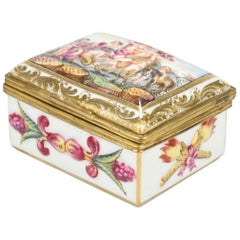Capodimonte Snuff Box
Early 20th Century Italian Rococo Revival Porcelain
Porcelain
People Also Browsed
20th Century Italian Neoclassical Decorative Bowls
Porcelain
Mid-20th Century Italian Mid-Century Modern Chandeliers and Pendants
Brass
Antique Late 19th Century French Rococo Revival Decorative Boxes
Porcelain
Antique Early 1900s German Rococo Dinner Plates
Porcelain
Mid-20th Century English Dinner Plates
Porcelain
Antique Early 1700s Chinese Qing Ceramics
Enamel
Antique 19th Century French Napoleon III Decorative Boxes
Brass
Antique 18th Century German Rococo Decorative Boxes
Porcelain
Antique 18th Century German Other Decorative Boxes
Gold
Early 20th Century French Belle Époque Decorative Boxes
Porcelain
Antique Mid-19th Century English High Victorian Taxidermy
Other
Antique 19th Century French Porcelain
Ormolu
Antique 19th Century French Louis XVI Jewelry Boxes
Bronze
Antique 1860s French Louis XVI Decorative Boxes
Bronze
Antique Late 19th Century French Louis XVI Centerpieces
Ormolu
Antique 18th Century German Neoclassical Snuff Boxes and Tobacco Boxes
Porcelain
Capodimonte for sale on 1stDibs
If success is measured by lasting name recognition, Capodimonte porcelain would seem to be in the same league as such makers as Meissen, Sèvres and Wedgwood. Early examples of Capodimonte lamps — as well as the Italian manufacturer’s celebrated porcelain vases, figurines and sculptures — can be hard to come by, but the best later pieces possess the same over-the-top charm.
The Real Fabbrica (“royal factory”) di Capodimonte hasn’t actually produced porcelain since the early 19th century, when Charles’s son Ferdinand sold it. Although secondary manufacturers have built upon the aesthetic and kept the name alive, some connoisseurs of the royal product feel these pieces should be labeled “in the style of” Capodimonte.
The timeline of royal Capodimonte porcelain is decidedly brief. From beginning to end, its manufacture lasted approximately 75 years. King Charles VII of Naples, who founded the manufactory in 1743, began experimenting with porcelain around 1738, the year he married Maria Amalia of Saxony. No coincidence there. His new bride was the granddaughter of Augustus the Strong, Elector of Saxony and founder of Meissen, the first European hard-paste porcelain manufactory. Her dowry included 17 Meissen table services.
Struck by porcelain fever, Charles built a dedicated facility on top of a hill (capo di monte) overlooking Naples. He financed expeditions to search for the right clay. He hired chemists and artisans to experiment. His earliest successes were small white snuffboxes and vases, although efforts soon progressed to full sets of tableware, decorative objects and stylized figurines of peasants and theatrical personalities.
In 1759, Charles succeeded to the throne of Spain. He moved the manufactory with him — including 40 workers and 4 tons of clay — and continued operations in Madrid. Twelve years later, his son Ferdinand IV, who inherited the throne of Naples, built a new factory there that became known for distinctly rococo designs.
The Napoleonic wars interrupted production, and around 1807, oversight of the royal factories was transferred to a franchisee named Giovanni Poulard-Prad.
Beginning in the mid-18th century, porcelain made by Charles’s factory was stamped with a fleur-de-lis, usually in underglaze blue. Pieces from Ferdinand’s were stamped with a Neapolitan N topped by a crown. When secondary manufacturers began production, they retained this mark, in multiple variations. The value of these later 19th- and 20th-century pieces is determined by the quality, not the Capodimonte porcelain marks.
Find antique and vintage Capodimonte porcelain for sale on 1stDibs.
Finding the Right Snuff-boxes for You
Today antique snuffboxes and tobacco boxes — as well as a lot of other vintage tobacco accessories — are collectibles and charming pieces of decor for any display case or to elevate your bookshelves.
Snuff, made of ground tobacco, was especially popular with Europeans in the 1600s. The ornate boxes to keep the powder dry became highly decorative by the 18th century. It was considered a must-have item, particularly for nobility.
The most important feature of a snuffbox was that it was airtight. The box protected the snuff from oxygen. Another crucial component was the flat lid.
Snuffboxes could be small enough to fit into a pocket or a larger container for communal use at the table. They also came in different shapes. Porcelain containers were prevalent and often designed to look like trunks. Others were oval or square. Boxes made with cowrie shells were rare and more expensive.
Snuffboxes were usually crafted from silver, gold, horn or tortoiseshell. Some of the most prestigious snuffboxes were French tabatières made of gold and sometimes glass. They could be adorned with amethysts, sapphires and diamonds and enameled, engraved or chased.
Sheffield, England, was known for its silver snuffboxes in the late 18th century as its silver-plating technologies perfected these containers. By the early 19th century, the silver industry in Birmingham, England, was producing elegant snuffboxes with images of abbeys and castles on the sides and top.
Another type of tobacco box was the snuff mull or mill. It was made out of horn or an entire ram’s head and topped with a metal lid, frequently featuring engravings and decorative hinges. These were fashionable in Scotland during the 19th century. The origin of its name is unclear.
On 1stDibs, find a plentiful range of antique snuffboxes and tobacco boxes to complement any home decor or furniture style. You can browse the collection by style, which includes Victorian, Georgian and Art Deco, or by material to find pieces in silver and gold.
- What is Capodimonte's style?1 Answer1stDibs ExpertFebruary 27, 2024Capodimonte's style is regal and opulent, though it has varied over the years. Early pieces from the celebrated Italian porcelain manufacturer often reflect Rococo design sensibilities, with organic motifs rendered in soft colors. As trends changed, so did the look of Capodimonte porcelain, which skewed Victorian, Edwardian and Art Deco over the years that followed. Capodiomonte has also looked beyond its native Italy for inspiration, producing porcelain ware that reflects Japanese and ancient Roman decorative techniques. Shop a wide range of Capdodimonte porcelain on 1stDibs.
